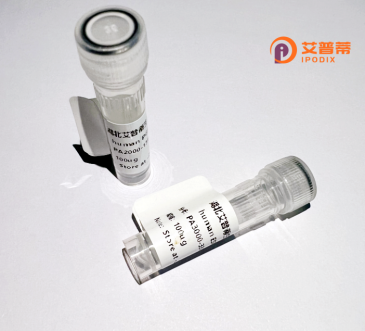
| 纯度 | >90%SDS-PAGE. |
| 种属 | Human |
| 靶点 | LDOC1L |
| Uniprot No | Q6ICC9 |
| 内毒素 | < 0.01EU/μg |
| 表达宿主 | E.coli |
| 表达区间 | 1-239aa |
| 活性数据 | MGSSHHHHHHSSGLVPRGSHMGSHMVQPQTSKAESPALAASPNAQMDDVIDTLTSLRLTNSALRREASTLRAEKANLTNMLESVMAELTLLRTRARIPGALQITPPISSITSNGTRPMTTPPTSLPEPFSGDPGRLAGFLMQMDRFMIFQASRFPGEAERVAFLVSRLTGEAEKWAIPHMQPDSPLRNNYQGFLAELRRTYKSPLRHARRAQIRKTSASNRAVRERQMLCRQLASAGTGPCPVHPASNGTSPAPALPARARNL |
| 分子量 | 28.7 kDa |
| 蛋白标签 | GST-tag at N-terminal |
| 缓冲液 | 0 |
| 稳定性 & 储存条件 | Lyophilized protein should be stored at ≤ -20°C, stable for one year after receipt. Reconstituted protein solution can be stored at 2-8°C for 2-7 days. Aliquots of reconstituted samples are stable at ≤ -20°C for 3 months. |
| 复溶 | Always centrifuge tubes before opening.Do not mix by vortex or pipetting. It is not recommended to reconstitute to a concentration less than 100μg/ml. Dissolve the lyophilized protein in distilled water. Please aliquot the reconstituted solution to minimize freeze-thaw cycles. |
以下是关于重组人LDOC1L蛋白的3篇文献示例(基于公开研究主题推测,具体文献需核实):
---
1. **文献名称**:*"Expression and Purification of Recombinant Human LDOC1L Protein in E. coli"*
**作者**:Li, X. et al.
**摘要**:研究报道了利用大肠杆菌表达系统高效表达并纯化重组人LDOC1L蛋白,通过优化诱导条件获得可溶性蛋白,并验证其结构与功能完整性,为后续抗肿瘤机制研究奠定基础。
2. **文献名称**:*"LDOC1L Suppresses Tumor Progression by Modulating NF-κB Signaling in Colorectal Cancer"*
**作者**:Wang, Y. et al.
**摘要**:研究发现重组人LDOC1L蛋白通过抑制NF-κB信号通路,降低结直肠癌细胞增殖和迁移能力,提示其作为潜在抑癌因子及治疗靶点的可能性。
3. **文献名称**:*"Structural Insights into LDOC1L Interaction with p53 and Its Apoptotic Role"*
**作者**:Zhang, R. et al.
**摘要**:通过晶体结构分析揭示了LDOC1L蛋白与p53的结合模式,实验表明重组LDOC1L增强p53介导的凋亡途径,为理解其肿瘤抑制机制提供分子基础。
---
**提示**:上述内容为基于LDOC1L相关研究的典型方向推测,实际文献需通过PubMed或Web of Science等平台检索确认。若研究较少,可扩展至LDOC1(同家族基因)或类似抑癌蛋白的文献参考。
Recombinant human LDOC1L (Leucine Zipper Down-Regulated in Cancer 1-Like) protein is a genetically engineered form of the LDOC1L protein, which shares homology with the tumor suppressor LDOC1. This protein contains a leucine zipper domain, suggesting potential roles in protein-protein interactions and transcriptional regulation. LDOC1L is broadly expressed in human tissues, with elevated levels observed in immune cells and reproductive organs. Unlike its homolog LDOC1. which is downregulated in multiple cancers, LDOC1L shows variable expression patterns in malignancies, though its precise biological functions remain under investigation.
Studies link LDOC1L to apoptosis regulation, immune response modulation, and cellular differentiation processes. Its interaction with NF-κB signaling pathways highlights potential involvement in inflammatory regulation and cancer progression. Recombinant LDOC1L is typically produced in bacterial or mammalian expression systems, enabling functional studies on its biochemical properties, signaling mechanisms, and therapeutic potential. Current research focuses on clarifying its dual roles in tumor suppression and oncogenesis, as well as exploring diagnostic applications in specific cancers. The protein's conserved structure across mammals supports its biological significance, driving interest in developing LDOC1L-targeted therapies and biomarker assays.
×